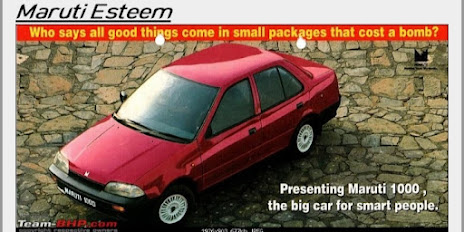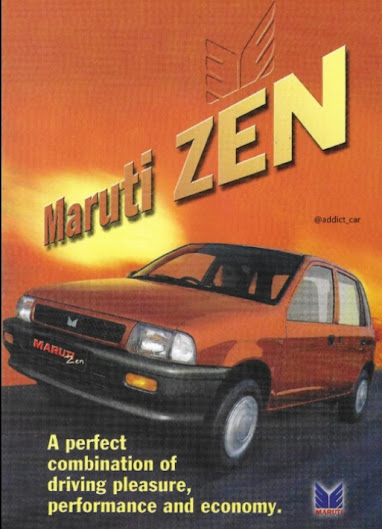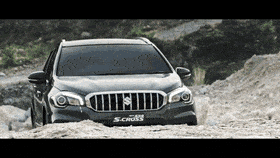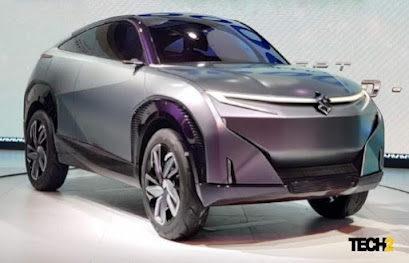Maruti Suzuki: not just a car, an emotion.....
In 1945, also came Mahindra & Mahindra which produced mainly heavy vehicles and jeeps for the defence and other govt. officials. They also produced some SUVs & MUVs for non- commercial use. This company was also helped by Willy’s company. During this period many other foreign car manufacturers used to import their cars in India, like, Cadillac, Chevrolet, Audi, Mercedes, Rolls Royce, Pontiac, Buick, Ford, and many more……….
BIRTH OF MARUTI: A mission of govt.
of India
In 1982, a license and joint venture agreement (JVA) was signed between Maruti Udyog Ltd., and Suzuki of Japan. At first, Maruti Suzuki was mainly import 2 fully built-up Suzuki in the first two years, and even after that, the manufacturers considerably. There were some concerns that the Indian market was
By 1991, 65 percent of the components, for all vehicles produced, were indigenized. After liberalization of the Indian economy in 1991, Suzuki increased its stake in Maruti to 50 percent, making the company a 50-50 joint venture with the government of India as the other stakeholder.
In 1993, the Zen,(which stands for "Zero Engine Noise") a 993 cc engined hatchback was launched and in 1994 the 1,298 cc Esteem sedan was introduced. It was modern, stylish, torquey and totally out of the crowd.
The first manufacturing factory of Maruti was established in Gurugram, Haryana, in the same year.
Maruti produced its 1 millionth vehicle since
In 1998, the new Maruti 800 was released, being
the first change in design since 1986. Zen D, a 1,527 cc diesel hatchback, and Maruti's first diesel vehicle, and a redesigned Omni were introduced. In 1999, the 1.6-litre Maruti Baleno three-box sedan and Wagon R were also launched.
India to launch a call center for internal and customer services. The new Alto model was released. In 2001, Maruti True Value, selling and buying used cars was launched. In
October of the same year the Maruti Versa was launched.
In 2003, the new Suzuki Grand Vitara XL-7 was introduced which was imported from overses, while the Zen and the Wagon R were upgraded and redesigned.
Maruti 800 after nearly two decades.
The five-seater Versa 5-seater, a new variant, was created while the annual sale of 472,122 units, the highest ever since the company began operations and the fiftieth lakh (5 millionth) car rolled out in April 2005.
Maruti Suzuki has two manufacturing facilities in Haryana (Gurgaon and Manesar), and one manufacturing complex in Gujarat wholly-owned by parent company Suzuki which supplies its entire production to Maruti Suzuki. All manufacturing facilities have a combined production capacity of 2,250,000 vehicles annually (1.5 million from Maruti Suzuki's two plants and 750,000 from Suzuki Motor Gujarat).
The Gurgaon manufacturing facility has three fully integrated manufacturing plants and is spread over 300 acres (1.2 km2).[22] The Gurgaon facilities also manufacture 240,000 K-Series engines annually. The Gurgaon facility manufactures the Alto 800, WagonR, Ertiga, XL6, S-Cross, Vitara Brezza, Ignis and Eeco. The Gurgaon facility also assembles the Jimny starting from January 2021 solely for export markets. It was reported the Indian-assembled Jimny will be exported to African markets and countries in the Middle East.[23]
The Manesar manufacturing plant was inaugurated in February 2007 and is spread over 600 acres (2.4 km2).[22] Initially it had a production capacity of 100,000 vehicles annually but this was increased to 300,000 vehicles annually in October 2008. The production capacity was further increased by 250,000 vehicles taking total production capacity to 800,000 vehicles annually.[24] The Manesar plant produces the Alto, Swift, Ciaz, Baleno and Celerio. On 25 June 2012, Haryana State Industries and Infrastructure Development Corporation demanded Maruti Suzuki to pay an additional Rs 235 crore for enhanced land acquisition for its Haryana plant expansion. The agency reminded Maruti that failure to pay the amount would lead to further proceedings and vacating the enhanced land acquisition.[25]
In 2012, the company decided to merge Suzuki Powertrain India Limited (SPIL) with itself.[26] SPIL was started as a JV by Suzuki Motor Corp. along with Maruti Suzuki. It has the facilities available for manufacturing diesel engines and transmissions. The demand for transmissions for all Maruti Suzuki cars is met by the production from SPIL.
In 2017, the new Suzuki Motor Gujarat facility was opened. This third facility is not owned by Maruti Suzuki, but instead wholly owned by Suzuki Motor Corporation. Despite that, the plant supplied vehicles to Maruti without any additional cost. Located in Hansalpur, Ahmedabad, the plant has the total annual capacity of 750,000 units.
In November 2021 Maruti Suzuki announce to set up a big plant in IMT Kharkhoda in Sonipat district across 900 acres with a investment of 18000 crore.
Haryana State Industrial and Infrastructure Development Corporation gives 900 acres of land to Maruti Suzuki for setting up a new plant in Industrial Model Township at Kharkhoda, Haryana.
From then, the company never looked back, and only prospered. Numerous new models were introduced every year. The main attraction of Maruti became that, it provided the people to fulfill their dreams of buying a car. Many of the people got a Maruti as their first car. We all have very sweet and nostalgic memories with these cars, and even today we all drive these. it consisted the taste of each and every sections of the society buying cars be it poor or rich, for private or commercial use, joint or nuclear family, enthusiastic, offroading or standard driving etc.
Maruti Suzuki: The Present
the carmaker has now a Wide range of cars of numerous variants and prices with a stake of 46%{as of 2021-22} at the national level which is the highest in the nation and among the rivals. Cars are available in various segments, whether it be SUVS,MUVS,Sedans, hatchbacks, crossovers, micro hatchbacks, premium hatchbacks, performance hatchbacks, vans, minitrucks etc. at exciting prices, easy EMIs, and at way affordable rate from the rest of the market. They also built a premium car sub-brand, NEXA in 2015 to provoke the buyers with royal and premium taste.
Under the terms of the alliance, the two automakers plan to acquire each other’s shares. Toyota plans to acquire 2,40,00,000 shares of common stock in Suzuki – which amounts to 4.94 percent ownership of the total number of shares issued by Suzuki as of March 31, 2019 (excluding treasury shares) – with a with a total value of JPY 96 billion (Rs 6,432 crore). This will be done by underwriting the disposition of treasury shares by way of third-party allotment conducted by Suzuki. Likewise, Suzuki plans to acquire, through purchase in the market, shares in Toyota equivalent to JPY 48 billion (Rs 3,216 crore).
As is known, the two companies began considering business partnership on October 12, 2016, and since then, they have continued to consider specific details. On March 20, 2019, the companies announced that they would begin specific considerations in order to engage in joint product development and collaboration in production, in addition to promoting the mutual supply of products, by bringing together Toyota’s strength in electrification technologies and Suzuki’s strength in technologies for small vehicles.
The Toyota and Suzuki partnership has already seen the launch of the Toyota Glanza, which is essentially a rebadged Maruti Suzuki Baleno. The alliance will also see Maruti Suzuki supplying the Vitara Brezza, the Ciaz and the Ertiga to Toyota. The two Japanese carmakers will also make a big push for hybrid electric vehicles in the country with Toyota supplying its hybrid systems to Suzuki. Additionally, they will cooperate to develop a new Toyota C-segment MPV that will be supplied to Suzuki as well.
Cognisant of the fact that the global automobile sector is currently experiencing a turning point unprecedented in both scope and scale – not only because of enhanced environmental regulations, but also from new entries from distinct industries and diversified mobility businesses – the two Japanese automakers intend to achieve sustainable growth, by overcoming new challenges surrounding the automobile sector by building and deepening cooperative relationships in new fields. They will also continue to be competitors while strengthening technologies and products in which each company specialises in and their existing business foundations.(autocar.com)
Maruti Suzuki: The Future
The company is now focussing on manufacturing more stylish, efficient, and safer cars. the company is nowadays considered to manufacture unsafe cars, with poor build and finish.But it is now struggling to build more safer cars with appealing crash test reports.In colab with Toyota,It is also planning to develop a mid-sized SUV and Hybrid Cars. One of its concept model was also showcased in the auto expo of 2020. The company is also planning to develop EV manufacturing facilities. for more info:
https://www.firstpost.com/tech/auto-tech/suzukis-india-plans-for-the-next-five-years-revealed-to-focus-on-electrification-and-suvs-9369421.html
-> Do you know? that the Maruti Zen was the first car of India to be manufactured and exported overseas.
-> Do you know? that the Maruti 800 was the first front-wheel-drive car produced in India. Earlier all were RWD.
-> Do you know, Maruti was the first company to build 100000 vehicles on the soil of India.
-> Do you know? Maruti was the first company to introduce 24x7 road side assistance and call helpline to India.
-> Do you know? Maruti Suzuki Baleno(2017) was the first car in India to offer Android Auto and Apple carplay at the same time.
-> Do you know? Maruti Zen was also the first Performance hatchback of India.
-> In 1997, 8 out of every 10 cars sold in India was a Maruti.
-> Maruti's assembly equipment of around 17000 robots helps it to roll out a new car every 12 seconds.
->Maruti Swift has won the INDIAN CAR OF THE YEAR award, 3 times, in all of its generations.(2006,2012,2019).
-> Maruti Suzuki Ciaz was the first car in India with a mild hybrid system.
**************************************************************
acknowledgements-
zigwheels, motorbeam, rushlane, teamBHP, ICOTY,EVO India, The Quint, Financial Express, Wikipedia, MS Arena Official, the real truth/yt.com, giphy.com, namaste car/yt.com, go mechanic.in and the entire Internet.


























.webp)
.webp)

.webp)





Comments
Post a Comment